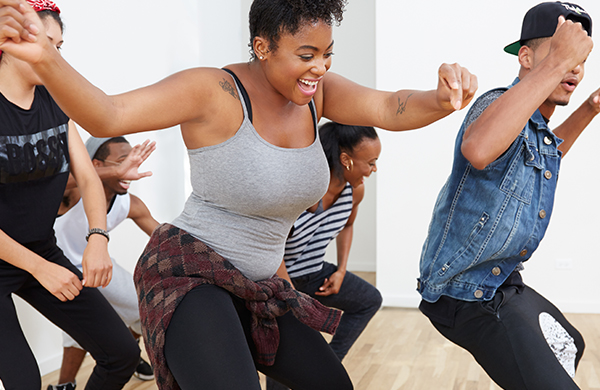
Getting fit or losing weight can be an ordeal. Listing those goals as New Year’s resolutions doesn’t make the process any easier. Yet every January, gyms and fitness studios see a deluge of newcomers, most of whom won’t make it to February. Many of those enthusiastic-at-first gym-goers are trapped in a cycle of stutter-starts and demoralizing stops. However, there is a key to escaping this routine and becoming a committed exerciser: workout planning.
Well, duh, you say, of course you need to plan your workouts. We’re not exactly talking about the step-by-step “30 minutes on this machine, 30 reps of these weights” type of plan—we mean the type of planning you need to do before even stepping foot in a gym. Our workout tips involve a review of yourself, your predilections, and your goals. So if you’re planning on hitting the gym and want your fitness routine to stick, consult these eight suggestions.
1. Examine why your last effort didn’t succeed.
If those who don’t learn from history are doomed to repeat it, your personal fitness history is worth examining. Before you devise a workout plan, consider your previous fitness ventures and why they didn’t work.
Perhaps, like Liz Kindel of Fairbanks, AK, you’ve had difficulty sticking with a fitness routine. “I would make plans with friends to work out, but [I] would become too tired or unmotivated and would cancel my plans to stay home,” she said. “Other times, I would have a consistent routine but would take a few days off—because ‘I deserved them’—and would fall off the wagon.”
Or maybe your story is more like Ryan Keser’s. “When I first started working out consistently about six—nearly seven—years ago, my insecurity stood in my way the most,” she said. “I would let the flimsiest of excuses get in the way of working out because I didn't want to go—I was too self-conscious. I didn't want people to see all my business jiggling around.”
Both Kindel and Keser, however, managed to work past their roadblocks to become committed fitness buffs, in part by taking the advice below to heart.
2. Adjust your attitude accordingly.
Now that you’ve figured out what went wrong last time, what’s different about this year’s workout plan? Hopefully, your attitude.
“First and most important, you have to want to make changes.”
– Ryan Markle, owner of R&N Fitness in North Pole, AK
Markle doesn’t mean that in a superficial way. Wanting to make changes has to take precedence over your other concerns and insecurities. If no amount of positive thinking can make you believe that no one at the gym is judging you, gather up some equipment—a yoga mat, hand weights, kettlebells—and work out with videos at home until you feel confident enough to take your exercise beyond your living room.
If, like Kindel, you have trouble maintaining a routine, there are a few routes you can take:
- Switch your workout time to the morning if getting your act together after work has been difficult. (Or vice versa.)
- Change up your workouts and schedule regular rest days to avoid burnout.
- Devise a consistent reward so you’re not coming up with ideas on the fly. For example, perhaps you’re only allowed to watch a certain trashy TV show if you’re on the treadmill.
3. Do your homework beforehand.

Once you’ve identified your previous pitfalls and adjusted your attitude, do some research. There are just as many workout routines as there are individuals, so you should find out what works best for you. Consult friends, fellow gym-goers, instructors, and online forums to decide what seems appealing. Here are a few ideas:
- Zumba is great for sociable people who’d like a low-pressure situation that still makes them sweat.
If a fitness class seems too challenging at first, speak with the instructor to figure out if there are any adjustments you can make before dropping out. If a fitness style doesn’t end up working for you, move to the next one on your list. And if you still aren’t sure, consult a personal trainer. They’ll be able to point you toward exercises that suit your interests and goals and teach you how to make them as rewarding as possible.
4. Get the appropriate gear.

Our experts agree on their general approach to fitness apparel: aim for comfort. Any old T-shirt and pair of shorts, sweatpants, or leggings should do. However, they also say it’s worth paying attention to the technical applications of some types of clothing and accessories. Markle and Kindel tend to wear wrist wraps and waist belts when they’re lifting for extra support and help preventing injury. Running or cross-training shoes are suitable for most exercises, but Keser said you’ll want less supportive shoes that encourage even distribution of your weight for lifting.
However, you’re welcome to be as discerning as you want. We previously discovered that people have very strong opinions about activewear, how much it should cost, and where it should be worn. For some, there’s value in investing in pricey athletic gear.
“I have a fairly curated sense of style outside the gym, and [luxury brands] let me indulge in that while at the gym. Most of my workout stuff is race shirts and pants I've owned forever, but it's nice to splurge on a workout piece that I really love and makes me feel good despite being sweaty and disgusting—in a good way—at the gym.”
– Ryan Keser
5. Remember that slow and steady wins the race.
Start slow. There’s no easier way to set yourself up for failure than so exhausting yourself that you never want to go back.
“You don't have to spend hours on end in a gym to make a change,” said Markle, the trainer. “Just go outside for a walk every night or do some sit-ups and push-ups before bed every night, and add one rep every week.”
Keser agreed. “I started with manageable chunks because I needed to feel a little success before I challenged myself. By setting myself up for success, I was more likely to continue with my fitness routine.”
And don’t be frustrated if it takes more time than you expected. Keser was first inspired to lose weight in January 2010, but it took her until April to figure out what worked best. “It took me those four months to come up with a plan that was manageable and sustainable for me,” she said. “And for me to come to terms with the fact that the journey couldn't and wouldn't be perfect.”
6. Set realistic goals to stay motivated.

Closely related to the need to start slow is the need to set realistic goals. As Keser stated above, achieving small successes kept her motivated to stay on track. For this part of workout planning, you’ll have to evaluate—perhaps with the help of a trainer or a doctor—exactly how fit you are.
If you’re totally new to the exercise thing, an appropriate short-term goal would be integrating strength training in one of your three weekly cardio workouts. A possible long-term goal could be being able to climb the flights of stairs to your office without huffing and puffing. If you’re starting from a fitter baseline, you could aim to hit the gym six times a week in the short term and strive to compete in a bodybuilding competition or marathon in the long term.
7. Switch it up whenever you—or your body—gets bored.
Your workout routine shouldn’t stay the same. You’ll inevitably get bored of it and, worse, your muscles will eventually adapt to it, so it will no longer be as challenging or as rewarding.
Kindel, for example, makes a point to change her surroundings. She goes to Planet Fitness for her morning cardio routine and is also a member of R&N Fitness, where she receives personal training from Markle, who is also her fiancé. “To switch up my environment every so often, I train at the military gym on the local Army base,” she said, which has different equipment from her other gyms.
Meanwhile, Keser often makes her workouts into social activities. After spending years working out at home, outside, or in apartment gyms, she joined LA Fitness, primarily because a friend is a member.
“It was nice to have a little camaraderie when jumping into something that feels as intimidating as joining a gym.”
– Ryan Keser
In addition, Keser is an assistant principal and leads boot-camp-style workouts for her teachers twice each week. The boot-camp sessions are just one element of her workout routine, though. To stay motivated, she mixes things up by adding in a run or cardio a few times a week, plus yoga classes.
8. Hold your own opinions in the highest regard.
Although all these suggestions are helpful, don’t be afraid to disregard them. Listening to your own body and your own sense of its strengths and limitations is the best course of action.
“Don't listen to anyone's advice. By that I just mean that you really have to do what works for you,” Keser said. “People always have a lot to say about how to ‘fitness,’ but ultimately it’s about choosing the pieces of other routines or things that work for you.”





